
Blackfriars is a restored Grade I listed 13th-century friary in Newcastle upon Tyne, Tyne and Wear, England, located in the city centre, close to the city's Chinatown.

CHIJMES is a historic building complex in Singapore, which began life as a Catholic convent known as the Convent of the Holy Infant Jesus (CHIJ). The complex is located at Victoria Street in the Downtown Core, within the Central Area, Singapore's central business district.

Blackfriars, Gloucester, England, founded about 1239, is one of the most complete surviving Dominican black friaries in England. Now owned by English Heritage and restored in 1960, it is currently leased to Gloucester City Council and used for weddings, concerts, exhibitions, guided tours, filming, educational events and private hires. The former church, since converted into a house, is a Grade I listed building.
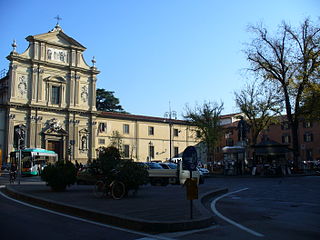
Museo Nazionale di San Marco is an art museum housed in the monumental section of the medieval Dominican convent of San Marco dedicated to St Mark, situated on the present-day Piazza San Marco, in Florence, a region of Tuscany, Italy.

St Andrew's Hall and Blackfriars' Hall or The Halls are a Grade I listed complex of former friary church and convent buildings in the English city of Norwich, Norfolk, dating back to the 14th century. They make up the most complete friary surviving in England. The complex is made up of several flint buildings. The centrepiece is St Andrew's Hall. The halls are now used for conferences, weddings, concerts, beer festivals and meetings. The maximum capacity is 1,200 people. It is one of the Norwich 12 heritage sites.
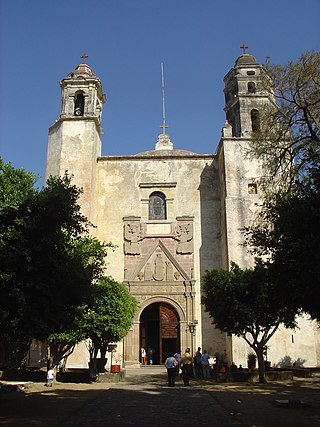
The Earliest Monasteries on the Slopes of Popocatepetl are sixteen earliest 16th-century monasteries which were built by the Augustinians, the Franciscans and the Dominicans in order to evangelize the areas south and east of the Popocatépetl volcano in central Mexico. These monasteries were recognized by the UNESCO as World Heritage Sites in 1994, because they served as the model for the early monastery and church buildings as well as evangelization efforts in New Spain and some points beyond in Latin America. These monasteries almost uniformly feature a very large atrium in front of a single nave church with a capilla abierta or open chapel. The atrium functioned as the meeting point between the indigenous peoples and the missionary friars, with mass for the newly converted held outdoors instead of within the church. This arrangement can be found repeated in other areas of Mexico as these friars continued to branch out over New Spain.

Burrishoole Friary was a Dominican friary in County Mayo, Ireland. Its ruin is a National Monument.
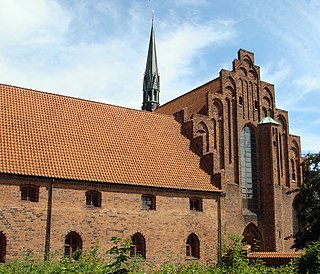
The Carmelite Priory, Helsingør, or Priory of Our Lady, Helsingør, was a house of Carmelite friars in Helsingør, Zealand, Denmark, established in 1430. It is the finest example of a complete monastic complex surviving in Denmark, and one of the best in all of Scandinavia.

St. Catherine's Priory was an important early Dominican friary, located in Ribe, Denmark from 1228 until 1536. The buildings still stand, although there is no monastic community there. Known as Ribe Kloster, it is Denmark's most complete extant monastic building complex.
Greyfriars, in Bristol, England, was a Franciscan friary. The name Greyfriars derived from the grey robes worn by the friars. It was founded at some time before 1234, within the town walls and then moved to Lewin's Mead in 1250. The site included extensive gardens surrounded by a stone wall. Following the Dissolution of the Monasteries in the sixteenth century, the premises were leased to the town council in 1541, who desired to use the stone to make repairs to the town walls, and the harbour facilities. In succeeding centuries many different uses have been made of the site, which is currently occupied by an office block and part of Bristol Dental School.

Derby Black Friary, also known as Derby Dominican Priory, or Blackfriars, Derby, was a Dominican priory situated in the town of Derby, England. It was also named in different sources as a friary, monastery and convent, but was officially a priory as it was headed by a prior. The "Black" came from the colour of the mantles worn by the friars of the order.

Blackfriars Friary was a medieval Dominican friary dating back to the thirteenth century. The remains of the friary, located in Hereford, England, consist of monastery ruins, a cemetery, and a stone preaching cross. The ruins are surrounded by a rose garden established by the local community in 1964.

The buildings known as Whitefriars are the surviving fragments of a Carmelite friary founded in 1342 in Coventry, England. All that remains are the eastern cloister walk, a postern gateway in Much Park Street and the foundations of the friary church. It was initially home to a friary until the dissolution of the monasteries. During the 16th century it was owned by John Hales and served as King Henry VIII School, Coventry, before the school moved to St John's Hospital, Coventry. It was home to a workhouse during the 19th century. The buildings are currently used by Herbert Art Gallery and Museum, Coventry.

Norwich 12 was an initiative by the Norwich Heritage Economic and Regeneration Trust (HERT) to develop 12 of Norwich's most iconic buildings into an integrated family of heritage attractions to act as an international showcase of English urban and cultural development over the last 1,000 years.

Austin Friars, London was an Augustinian friary in the City of London from its foundation, probably in the 1260s, until its dissolution in November 1538. It covered an area of about 5.5 acres a short distance to the north-east of the modern Bank of England and had a resident population of about 60 friars. A church stood at the centre of the friary precinct, with a complex of buildings behind it providing accommodation, refreshment and study space for the friars and visiting students. A large part of the friary precinct was occupied by gardens that provided vegetables, fruit and medicinal herbs.
The Black Friary was a Dominican friary located in Trim, County Meath, Ireland.

Bruges is the capital and largest city of the province of West Flanders in the Flemish Region of Belgium, in the northwest of the country, and the sixth-largest city of the country by population.
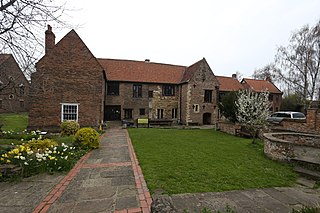
Beverley Friary is a row of buildings in Beverley, East Riding of Yorkshire, England. The buildings are a Grade II* listed building that since 1984 have been used as a youth hostel. They are thought to be either part of an old Dominican friary, or to have been built on the site of the friary using stone from the site.

Ten Duinen Abbey or the Abbey of the Dunes was a Cistercian monastery at Koksijde in what is now Belgium. It was one of the richest and most influential religious institutions in the medieval County of Flanders. It later relocated to the city of Bruges.
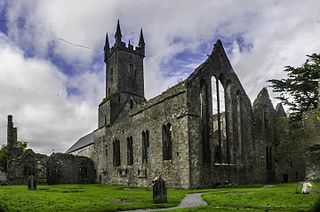
Ennis Friary was a Franciscan friary in the town of Ennis, County Clare, Ireland. It was established in the middle of the 13th century by the ruling O'Brien dynasty who supported it for most of its existence. Following the suppression of the monasteries in the 16th century, the friary continued to function for a while despite the loss of its lands. In the early 17th century, the buildings were handed over to the Church of Ireland as a place of worship. It was used as such until the late 19th century. After the construction of a new Church of Ireland building, the friary fell into ruin. Managed by the Office of Public Works since the late 19th century, it was formally returned to the Franciscan Order in 1969.



















